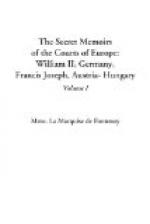In fact there was so much of the phraseology and style habitual to Princess Charlotte in the letters, that they would inevitably have been, as I remarked above, positively ascribed to her had it not been for the grossly improper and even disgusting twist and construction that was invariably added to her well-known manner of writing. Although a terrible flirt as well as a daring coquette, the princess has never been charged with anything more serious than trivial affaires de coeur, excepting by the writer of the anonymous letters.
Then too, as I have also already stated many of these letters assailed the princess herself, in the most unscrupulous fashion; an abominable and impossible story, picked up from the filthiest of Berlin gutters, impugning the legitimacy of the only child of the princess, being thus circulated far and wide. This vile fabrication alleged that Charlotte had been married off in a hurry to Prince Bernhardt of Saxe-Meiningen, in order to avoid a public scandal. It is only necessary to recall the fact that the sole child of Princess Charlotte, Princess Fedora, now married to Prince Henry of Reuss, was born twelve months after her mother’s marriage, in order to show how utterly without foundation was this shameful slander. At least a dozen anonymous letters sent to the emperor and to various other personages dealt with an episode said to have taken place during a trip undertaken by the princess in Norway and Sweden. She was attended on that occasion by a Captain von Berger, and his wife, who were her gentleman and lady-in-waiting, and there was also in her suite a diminutive officer holding the rank of lieutenant, and bearing the old Silesian name of Count Schack, who acted as aid-de-camp.
According to the anonymous letters, Princess Charlotte made a kind of toy of the little officer, and behaved in a most volatile manner. There was evidence of such intense malignity in these letters against Princess Charlotte that they were attributed to a jealous woman, and that if not actually written by one, they had at any rate been inspired by a member of the fair sex.
There can be no doubt that Princess Charlotte and her husband ended by sharing the opinion entertained by the Schrader-Hohenau clique, about the letters being inspired by Baroness Kotze, and written by her husband, and it must be confessed that there was a certain amount of ground for their doing so. The blotting pads used by Baron Kotze, both at the Union Club and elsewhere, were subjected to much the same microscopic examination as those of Duke Ernest-Gunther of Schleswig-Holstein, and when at length a distinct degree of similarity was discovered to exist between the caligraphy of the anonymous letter writer and the impressions which figured on the blotting pads habitually used by Baron Kotze, Baron Schrader drew up a report on the subject, charging Baron Kotze with being the author of the letters, and presented it to the emperor. The latter hesitated a little




